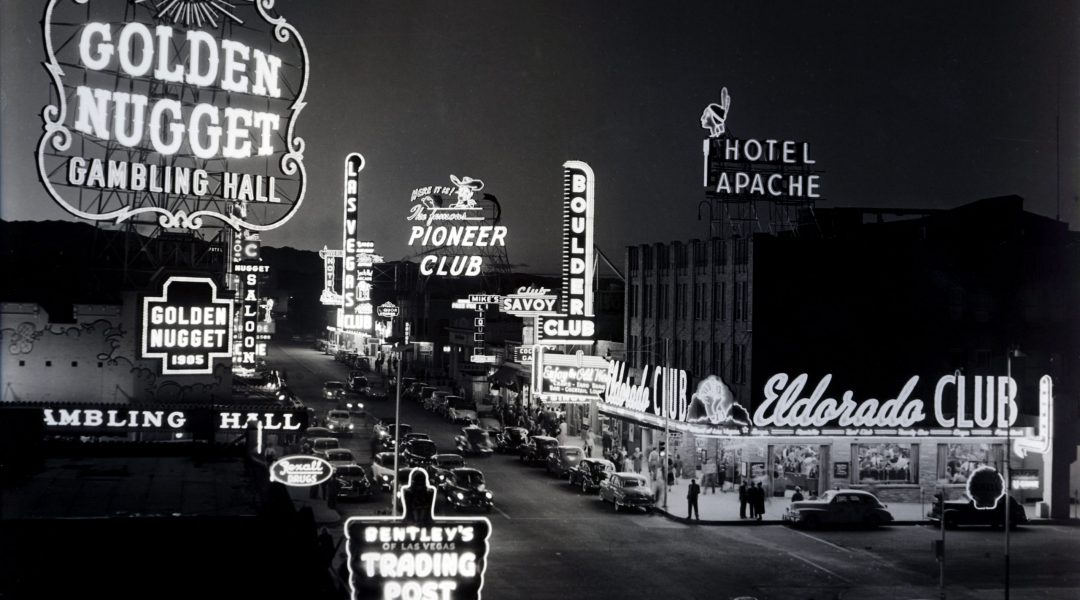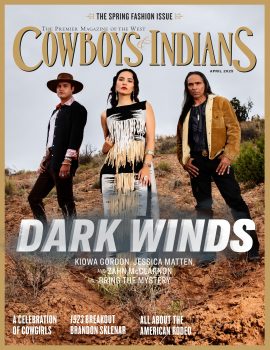
How Las Vegas went from frontier town to America's playground.
In 1960 Warner Bros. released Ocean’s Eleven, starring Frank Sinatra, Dean Martin, Sammy Davis Jr., and Peter Lawford as retired members of an elite commando unit who have reunited to execute a daring casino heist in Las Vegas. Critics were less than impressed, but the film ranked among the top 10 box office draws of the year.
In retrospect, the critics were probably right — as Leonard Maltin observed, “Entire Rat Pack’s in it, but no one does much.” The passage of time, however, has transformed Ocean’s Eleven into an invaluable record of a time when Las Vegas really was America’s guilty pleasure.
“Sin City” is just a slogan on the postcards now, but in the Vegas of 1960, a freewheeling, devil-may-care atmosphere still reigned under the watchful eye of the mob. Those were the days before the gambling halls were taken over by corporations and turned into palatial mega-resorts that could advertise themselves as family-vacation destinations with a straight face. Today’s Las Vegas may attract more than 38 million visitors a year, but the Vegas of legend is in Ocean’s Eleven.
Joyce Moore affectionately remembers that time. A Las Vegas resident since 1953, Moore worked at the Las Vegas Hilton (now the Las Vegas Hotel & Casino) for 16 years and is now an archivist in the historic special collections department in the main library at the University of Nevada, Las Vegas. Like many others with deep roots in the community, she believes the town ran better when guys with names like Lefty and Bugsy were in charge.
“The ‘family’ members were the nicest people in the world,” Moore recalls, avoiding the term mobster. “They were accessible, very kind to the patrons, and always happy to buy you a drink. Sure, if you crossed them they may have had you killed,” she notes with a laugh, “but otherwise you didn’t see that side. You just saw some very gracious hosts.”
Gambling in Nevada actually predates organized crime. Las Vegas, originally established in 1905 as a water stop for the railroad between Salt Lake City and Los Angeles, was home to a few illegal gaming establishments, like most frontier towns in the Old West. In early 1931 construction began on the Hoover Dam, just 30 miles outside the city limits. That project brought thousands of construction workers to the area who needed something to do after work, and gambling was legalized that same year.
Legend has it that Bugsy Siegel transformed Las Vegas into a tourist Mecca with the opening of the Flamingo Hotel in 1946. But the first gaming resort on what would become the Las Vegas Strip was El Rancho Vegas, opened in 1941, followed by the Last Frontier one year later. While Siegel’s casino magnate days didn’t last long — he was suspected of dipping into the hotel building fund and executed in 1947 — the success of the Flamingo helped to inaugurate a two-decade building boom largely financed with syndicate capital.
By the 1960s, the Strip was home to the Desert Inn, the Sahara, the Riviera, the Dunes, the Tropicana, Caesars Palace, and the Sands, also known as home base for a coalition of entertainers known as the Rat Pack. Its membership — Frank Sinatra, Dean Martin, Sammy Davis Jr., Peter Lawford, Angie Dickinson, Joey Bishop, and Shirley MacLaine — appeared together for the first and only time in Ocean’s Eleven. True, they don’t do much, but no one ever looked better doing it.
The appeal of watching Frank, “Dino,” and Sammy smoke cigarettes, drink Scotch, and bounce silly lines off each other may be lost on current and future generations, but those old enough to remember will tell you that the Rat Pack was the ruler by which cool was measured. They personified the Vegas vibe of escaping a routine life to stay up all night, with no shortage of things to do at 3 a.m. — the restaurants were open, the lounges were jumping, and there was always room for one more at the blackjack table.
Las Vegas also acquired a theme song in the 1960s courtesy of Elvis Presley. “Viva Las Vegas” was introduced in the film of the same name starring Presley and Ann-Margret. The lyrics (“If you see it once, you’ll never be the same again”) offered further enticement of the forbidden delights that, long before the era when most states have at least a few casinos, could only be experienced in Las Vegas. The movie, along with Ocean’s Eleven and Diamonds Are Forever, is a Technicolor time capsule of the city’s heyday. When Sinatra, Elvis, and James Bond are all in the same city, you know it’s the place to be.
Billionaire Howard Hughes joined the party in 1967, buying the Desert Inn for $13.2 million and converting the ninth floor into an armed and airtight living space. After a $300 million shopping spree, Hughes acquired six casinos, a television station, and huge tracts of the surrounding desert. He then set out to make Vegas even more glamorous than previously imaginable.
Bob Stoldal worked for Hughes’ station, eventually becoming its news director. Today, Stoldal is vice chairman of the board of the Las Vegas Historical Preservation Commission and a board member at The Mob Museum, which opened in February 2012. “I arrived in Las Vegas in 1957, and the first two words I learned were points and juice,” Stoldal says. (For the uninitiated, points is a reference to ownership in a hotel-casino; juice is interest owed on a loan.) Before his media career began, Stoldal worked as a busboy at the Dunes, the Riviera, and the Stardust. Back then, he says, Las Vegas was “still this tantalizing tidbit in the desert run by organized crime.”
But when people remember that era fondly, it’s often more about the wide-open spaces than the wise guys. “The town was smaller and more intimate,” Stoldal says. “In those days the big hotels had 500 rooms, which would be tiny now. But Vegas is still the same. When you come here you bring your image of what you want to experience — then and now.”
The influx of Howard Hughes capital was followed in 1967 by the Corporate Gaming Act, which for the first time allowed publicly traded companies to own Nevada casinos. That was the beginning of the end for mob rule. “When that law was passed, the corporations moved in and every venue had to make a profit,” recalls Moore. “The hot dog stand out by the pool had to make money or they closed it down. In the 1960s, they would give you free hot dogs; the hotel chuck wagons were free between midnight and 6 a.m. Now everything is about the bottom dollar.”
The “anything goes” atmosphere — back when the Sands could run a literally “floating” craps game in the hotel pool, and Jerry Lewis could finish his act in the showroom then deal a few hands of blackjack in the casino, making sure everybody won — was replaced by strict Gaming Commission laws that regulate every roll of the dice. And the distinct clanging of silver dollars into metal trays has been replaced by the silent swipe of magnetic cards, as money invisibly changes hands.
Las Vegas 2012 is like the 1960s version on performance-enhancing martinis. Everything is bigger, more luxurious, and more expensive. The skyline once resembled God’s miniature golf course with castles, Roman temples, and circus tents. Now these curios blend with modern glass and steel structures that would look right at home in New York City. Many of the legendary resorts of the ’60s are gone, including three of the five that Sinatra’s gang held up in Ocean’s Eleven.
“If we don’t need something anymore we blow it up,” Moore says, referring to the medley of hotel implosions of the last two decades. She still misses the Dunes and its sumptuous Sultan’s Table restaurant. “They had a revolving stage in the middle with all these violinists and a grand piano. It was the most elegant thing I had ever seen.”
Still, even a Las Vegas historian has to admit that most of those hotels had to be razed. “They endured a lot of stress, especially in the plumbing. Until they built the Desert Inn they didn’t even have a sewer system on the Strip,” Moore says. “It got to the point where it was just less expensive to start over.”
With a little foresight, someone might have thought of saving more of the ephemera — the signs and the gaming tables — and re-created, say, the Sands casino and the Copa Room in an interactive museum. That way future generations could absorb the sights and sounds of vintage Vegas. But this is a city always more concerned with looking forward than looking back.
“When he opened The Mirage, Steve Wynn told me that Las Vegas has to reinvent itself every five years,” recalls Stoldal. “It’s always a challenge figuring out what to preserve.”
Las Vegas paid for its wrecking-ball hubris during the recession from which it is just now starting to emerge. While every city was hit, Las Vegas was walloped like a mob snitch. The Stardust and the Frontier were imploded amid fireworks and lofty promises of more elaborate resorts to come; neither has been replaced. The Frontier land is now a vacant lot in the center of the Strip, while the neighboring Stardust project got as far as the L-beam frame before construction was abandoned.
But these setbacks, like others the city faced through its colorful history, will eventually be surmounted, with promises of new wonders to come. “Las Vegas is one of the most exciting towns in the world,” Stoldal says. “When you live here you forget that sometimes, but all you have to do is head to the Strip and see thousands of people enjoying themselves, and you realize this is still a magical oasis in the desert.”
From the December 2012 issue.














